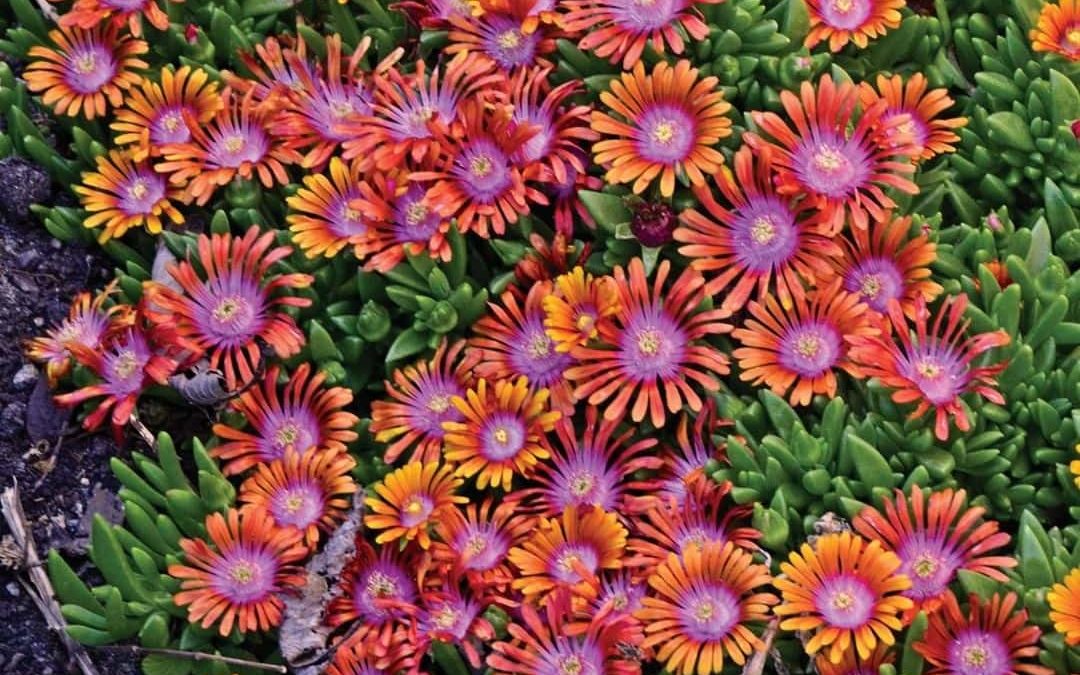Ice Plants
The Ice plant is the common name referring to a wide variety of Lampranthus and Delosperma plant classifications. Lampranthus and Delosperma are both in the family Aizoaceae which are frequently regarded as succulents. They both originate in either Southern or Eastern African regions preferring warmer climates. Ice plants get their unique name from the tiny hair-like protrusions on the plant that is able to reflect light. Ice plant care is easy, just about anyone can grow this beautiful plant.
Ice plants will flourish in any sandy or dry soil, which is not beneficial to many other plants. You will be able to plant during the fall if you live in a warm southern area but consider planting your Ice plant during the middle of the summer if you live in a colder region.
These hairs shimmer reflecting the light as they resemble tiny ice crystals. Other names for the Ice plant include the Sea Fig or the Sea Marigold. Like most succulents, the foliage of the Ice plant is rather fleshy and green in appearance. They also produce pink, red, purple, or yellow flowers during the summer months that are quite similar to daisies or asters.
Do Ice Plants need sun or shade?
Ice plants require the full and direct sun to provide optimal growth of the plant and blooming of its flowers. Typically, an Ice plant will succeed with about six to eight hours of direct sunlight daily. Ice plants can survive if they are partially shaded, but their flowers will not bloom as frequently. Consider getting an Ice plant since they are a perfect addition to rock gardens or any sunny and seemingly tough area.
This extremely hardy plant can survive in many different regions and is one of the few cold-resistant succulents that are available. Whether in the ground or pot, the Ice plant is relatively easy to maintain and care for as a plant beginner. The Ice plant will add a unique and bright pop of color to the start of your plant collection.
During the spring, the Ice plant is an essential addition to your garden if you are looking to attract butterflies, bees, and other pollinators. Ice plants are not meant for human or animal consumption, making them resistant to deer and rabbits. Ice plants do very well in many regions since they do not require specific soil types. Their only requirement besides the sun is that the soil has good drainage.
Do Ice Plants come back every year?
Ice plants are generally considered to be evergreens maintaining their appearance throughout more than one growing season. They are, in fact, perennials preferring the temperature of warmer climates where they can flourish all year long. The Ice plant continues to display its vigorous appearance throughout most of the year.
As the colder weather of fall approaches, Ice plants will experience a bit of dieback and will turn a slightly darker color. During the late spring, however, Ice plants will display new seed growth, causing the plant to spread.
Perennials are wonderful plants for your garden because they’ll continue to come back next year. It’s important to have a plan for where you want these plants to grow. We offer landscaping services to help plan and install your yard and garden needs.
What is an Ice Plant good for?
Ice plants have been studied by the medical community and have shown signs to suggest that they possess diuretics or diluting activity. The juice of the plant is said to have a watery and slightly nauseating taste but has proven beneficial in eliminating symptoms of ascites, dysentery, pneumonia, as well as liver and kidney diseases. Externally, you can use the juice of the Ice plant to relieve pain, swelling, itchiness, or redness of the skin.
How fast does an Ice Plant spread?
A single Ice plant can grow outwards to about four feet, so it is extremely important in regards to where you choose to plant it. The Ice plant can accomplish this in two to three months, which is why it is considered an invasive species.
Naturally drought resistant, the Ice plant is a phenomenal selection for providing growth in desolate areas. Ice plants seem to thrive wherever they are planted, supplying ground cover.
These hardy plants can also survive in many dry and nutrient sparse areas. This is exceptional since the Ice plant can be utilized in areas that most plants consider uninhabitable. Places such as rock gardens, sloping land, edging, and desert gardens. Unfortunately, Ice plants are considered to be quite invasive, having taken over many parts of Southern California.
How much water do Ice Plants need?
Ice plants are drought resistant, which means they do not require a lot of water. It is important to remember to water your plant quite sparingly to avoid water logging or over watering. You should typically only need to water your Ice planet about every two weeks during the growing period.
As the winter months approach, allow the soil of your plant to dry out completely to ensure it survives this period. If your Ice plant is in the ground and snow is expected, be sure to lay out some dry mulch that will help keep it dry.
Having an irrigated sprinkler system is a great way to keep your garden watered efficiently.
Common Ice Plant problems
Although the Ice plant is considered to be a hardy survivor, there are a few dangerous pests and diseases that can cause damage to your plant.
First, there are the sucking insects known as aphids that will spread disease to your ice plant as they feed upon the undersides of its leaves.
They will also leave a sticky residue on the plant that will attract ants that can destroy your Ice plant. Mealy bugs are also detrimental, leaving cotton-like substances. They will proceed to suck the juices from your plant, causing reduced growth as well as later attracting ants.
Another pest to know is the Spider mite which will suck the chlorophyll from your Ice plant while injecting toxins that will cause the foliage to dry out and turn yellow. Slugs can also harm your Ice plant leaving large holes in your plant’s foliage. Eliminating these pests from your Ice plant can be reached through either chemical pesticides, biological control methods, or natural home remedies.
Ice Plants for Sale
Take advantage of our Ice Plant guide by growing some purple flowers of your own!
Visit our nursery at Troy Tropics and turn your backyard into an outdoor oasis.
Our team of greenery experts can help you decide on the best plants for your home. Contact us through our online form or call us directly at (941) 923-3756.






